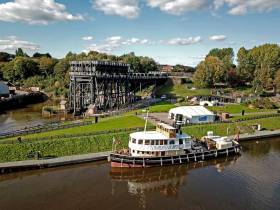Displaying items by tag: Great Canal Journeys
Historic Canal Ship Future Safeguarded by UK Ports Group
#HistoricShips - One of Liverpool’s most significant historic vessels will have a more secure future thanks to a donation from the the operator of the UK north-west port, the Peel Ports Group.
The safeguarding of the steam-powered former tug Daniel Adamson, featuring art-deco interiors, is for the next three years thanks to the donation of £75,000.
According to Peel Ports, the Daniel Adamson Preservation Society (DAPS) – is a volunteer group which led the £5m restoration project of the ‘Daniel Adamson’ Steam tug-tender, and with the investment from the port operator will benefit towards a long-term legacy project committed to teaching others about the vessel and its rich ties to the area.
The vessel built in 1903, affectionately known as the ‘Danny’, is the oldest surviving steam-powered tug to be built on the Mersey. Design of the tug was custom-built to tow the long strings of barges from the inland towns of Cheshire. From there the tug conveyed cargoes to and from the Potteries to the Port of Liverpool.
As mentioned in the news recently is the Cammell Laird shipyard in Birkenhead, where the Danny was acquired by the Manchester Ship Canal Company in 1921. The tug was used to transport visiting VIPs around Manchester’s famous inland docks and along the ship canal.
In more recent times, the veteran vessel was earmarked for scrap in 2004, at which point the DAPS was formed to save this unique tug.
Save The Date: Shannon-Erne Waterway To Feature On TV's 'Great Canal Journeys' On 8 November
#InlandWaters - The waters of the Lough Allen canal, Lough Erne and the Shannon-Erne Waterway will feature in the new series of Channel 4's Great Canal Journeys.
Presenters Tim West and Prunella Scales filmed in the area in July 2015, beginning their journey in Drumshanbo, and between music sessions, poetry and hyrdoelectric locks, they tried everything on the trip up the canal and out onto Lough Erne where they visited islands, homes and castles.
The series starts this coming Sunday (25 October), and the Irish episode will be broadcast at 8pm on Sunday 8 November on Channel 4, with catch-up available later via the channel's on-demand service All4.























